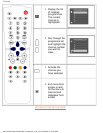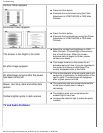
Q: What are S-VIDEO Signals?
A: These are 2 separate Y/C video signals from the S-VIDEO and Hi-8 recording standards. The
luminance signals Y (black and white) and chrominance signals C (colour) are recorded separately
on the tape. This provides a better picture quality than is achieved with standard video (VHS and 8
mm) where the Y/C signals are combined to provide only one video signal.
RETURN TO TOP OF THE PAGE
LCD Panel Technology
Q:
What is a Liquid Crystal Display?
A: A Liquid Crystal Display (LCD) is an optical device that is commonly used to display ASCII
characters and images on digital items such as watches, calculators, portable game consoles, etc.
LCD is the technology used for displays in notebooks and other small computers. Like light-emitting
diode and gas-plasma technologies, LCD allows displays to be much thinner than cathode ray tube
(CRT) technology. LCD consumes much less power than LED and gas-display displays because it
works on the principle of blocking light rather than emitting it.
Q: How are LCDs made?
A: LCDs are created from two glass plates separated from each other at a distance of a few
microns. The plates are filled with liquid crystal and then sealed together. The top plate is coloured
with an RGB pattern to make the colour filter. Polarizers are then glued to both plates. This
combination is sometimes called 'glass' or 'cell.' The LCD cell is assembled into a 'module' by
adding the backlight, driver electronics and frame.
Q: What is polarization ?
A: Polarization is basically directing light to shine in one direction. Light is electromagnetic waves.
Electric and magnetic fields oscillate in a direction perpendicular to the propagation of the light
beam. The direction of these fields is called the 'polarization direction'. Normal or non-polarized light
has fields in several directions; polarized light has a field in only one direction.
Q: What differentiates passive matrix LCDs from active matrix LCDs?
A: An LCD is made with either a passive matrix or an active matrix display grid. An active matrix has
a transistor located at each pixel intersection, requiring less current to control the luminance of a
pixel. For this reason, the current in an active matrix display can be switched on and off more
FAQs (Frequently Asked Questions)
file:///D|/TV/english/150mt/safety/saf_faq.htm (5 of 8) [12/24/2002 11:43:38 AM]


















